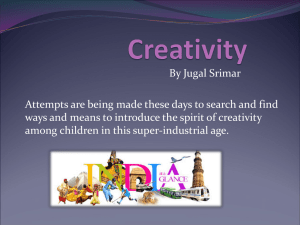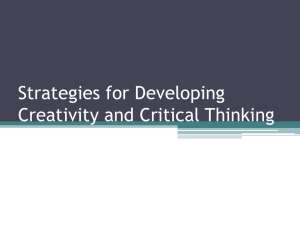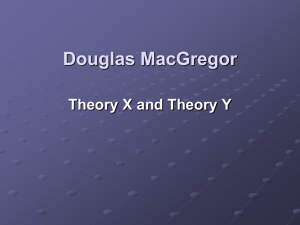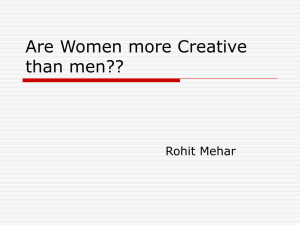2014 ICIE Conference Keynote
advertisement
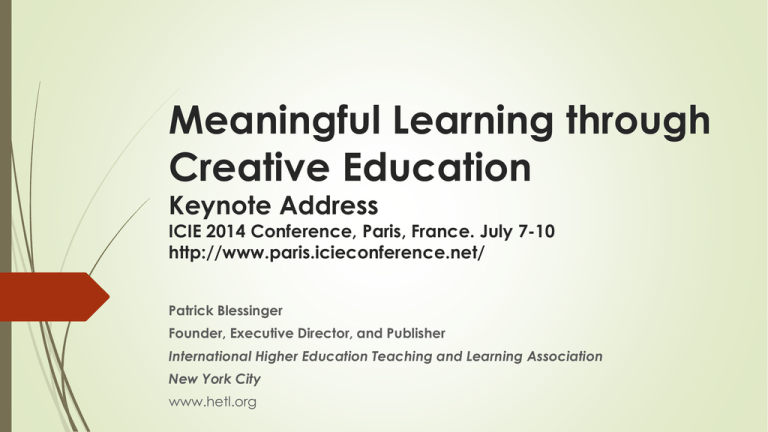
Meaningful Learning through Creative Education Keynote Address ICIE 2014 Conference, Paris, France. July 7-10 http://www.paris.icieconference.net/ Patrick Blessinger Founder, Executive Director, and Publisher International Higher Education Teaching and Learning Association New York City www.hetl.org The Purpose of Education Education has multiple aims – political, economic, socio-cultural, personal. However, the main focus of education should not be purely vocational but rather in nurturing interests, skills, and knowledge across an array of topics that are personally meaningful and individualized to each student. The ultimate goal education should be to prepare students for life in all its complexities, not just training for a job. Overview of Creativity History and Definitions Brilliant. Genius. Talented. Creative. Innovative. Gifted. All words used to describe exceptional types of mental performance. Some believe that creativity is mainly the province of geniuses and artists. I argue that creativity (creative learning) is the essence of higher order thinking. I argue that creativity is a practical life skill that should be nurtured in everyone from an early age through formal education. See Sawyer, R.K., (2012) Explaining Creativity; Csikszentmihalyi, M., (1996) Creativity. Overview of Creativity History and Definitions Creativity can be defined as a new combination of mental activities expressed in the world (individual level; bottom-up approach; reductionism) Creativity can be as the creation of a novel idea that is valuable to society (social level; top-down approach; holism). The social view contends that creativity not only emerges from individual human minds but also emerges from social processes. See Sawyer, R.K., (2012) Explaining Creativity; Csikszentmihalyi, M., (1996) Creativity. Overview of Creativity History and Definitions In Csikszenthmihali’s system view, there are three components to the creative process: 1. Domain: set of knowledge - rules, methods, assumptions (.e.g., math, history, engineering, economics, education, medicine, or sub-domains. The domain is where the acceptance of the creative idea leads to change. 2. Field: group of experts who determine if a new idea should accepted as part of the domain (e.g., physicians or chemists or historians – usually the experts in the field like researchers. 3. Individual: the one who generates the idea(s). The individual who comes up with a great transformative idea has first mastered the domain – she/he understands the domain deeply and the rules by which it is organized. Overview of Creativity History and Definitions The word creativity first appeared in English in the 1875 text History of Dramatic English Literature, by Adolphus William Ward (Weiner, 2000, p. 89). Engel (1981)and Taylor (1989) state that the concept of imagination emerged from England and Germany during the late 18th Century and it was viewed as a quality of the mind responsible for originality and is central to the modern Western concept of creativity. Given all this, other definitions of creativity could be: the meaningful application of imagination or the process of generating original ideas that have value to society. Overview of Creativity Waves of Creativity The formal study of creativity is new and has occurred in four major phases, according to Sawyer (2012): First wave (1950s and 1960s): focus on studying personality traits (personality approach) Second wave (1970s and 1980s): focus on studying mental processes (cognitive approach) Third was (1980s and 1990s): focus on studying creative social systems (sociocultural approach) Fourth wave (1990s to present): integrative study of creativity (interdisciplinary approach) Creativity and Imagination Creativity: the meaningful application of imagination Creativity and Imagination Creativity: the meaningful application of imagination Imagination is the primary gift of human consciousness. Sir Ken Robinson, Out of Our Minds: Learning to be Creative Creativity is a unique human quality and the essence of higher order thinking. Creativity is the result of a highly developed nervous system and cerebral cortex How do we use creativity in novel and meaningful ways to explore new possibilities for ourselves and for society? How do we foster creativity in an educational system defined largely by conformity, standardization, and hyper-specialization. See Sawyer, R.K., (2012) Explaining Creativity; Csikszentmihalyi, M., (1996) Creativity. Creativity is Important to Humanity Creativity: the meaningful application of imagination In a world where lifelong employment in the same job is a thing of the past, creativity is not a luxury. It is essential for personal security and fulfillment. Sir Ken Robinson, Out of Our Minds: Learning to be Creative Creativity will grow in importance due to: Increasingly globalized world (e.g., politically, economically, socially, environmentally) Increasingly sophisticated information and communication technologies (ICT) Jobs that don’t require creativity are being automated Increasing demand for creative services The most perplexing problems (e.g., wicked problems) confronting humans will require much higher levels of creative thinking No one discipline or profession alone can claim to have the best or only approach to solving life’s most difficult and perplexing problems Creative Learning Bloom’s Taxonomy of Learning Objectives Creativity is as important in education as literacy and we should treat it with the same status. Sir Ken Robinson ANDERSON, L W, & KRATHWOHL D R (eds.) (2001). A Taxonomy for Learning, Teaching, and Assessing: A Revision of Bloom's Taxonomy of Educational Objectives. New York: Longman Meaningful Learning Creativity from a Meaning-making Perspective Meaningful learning is aimed at supporting the capacity of the individual to create an authentic, creative, and experiential project of her/his life. With meaningful learning, the goal is to co-create a learning environment where individuals become more self-regulated, self-sustaining, self-determining authors of their own lives. With meaningful learning, the focus of learning is on critical and creative thinking, and on psycho-social selfdevelopment. Creative Learning Creativity Research Sawyer (2012), in an exhaustive study of creativity research over the last few decades concluded that: Creativity involves both divergent and convergent thinking. Creativity normally occurs incrementally over a long period of time. Creativity is the result of hard work and commitment to solving a problem. Creativity is a directed, intentional, rational process. Hyper-specialization may stifle creativity if it means you are unware of related knowledge. Although creativity is largely domain-specific, crossfertilization can enhance creativity. Creative Learning Creativity Research Sawyer (2012), in an exhaustive study of creativity research over the last few decades concludes that: There is no creativity gene and creativity doesn’t occur in just the right half of the brain. Rather, it involves basic psychological and social processes put together in novel and complex ways. Imagination (i.e., the ability to form new images and thoughts not available through the senses or not possible in conscious reality) occurs at the individual level (in the mind). Innovation (i.e., implementing a new idea or product into a group or society) occurs at the social level. Creativity Learning Stages of the Creative Process Sawyer (2012): integrated framework of major theories of creativity which emerged eight stages of the creative process: 1. Identify the problem or opportunity Problems or opportunities are rarely neatly presented Problems requiring the most creativity are unstructured Cannot be solved by one discipline or past experience alone 2. Acquire knowledge and skills relevant to the specific problem Gardner (1993) showed that creative breakthroughs usually occur after about ten years of deep immersion in the domain Ericsson et al (1993) assert that world class performance in any domain requires at least 10,000 hours of deliberate practice These studies suggest that prolonged, intensive immersion in a domain is required for highly creative performance Creativity Learning Stages of the Creative Process 3. Acquire a broad range of knowledge related to the problem See the overlaps and relationships across domains Use analogic thinking (i.e., make analogies across domains) Apply concepts from related domains Generate a variety of ideas 4. Allow time for deep reflection 5. Generate a variety of ideas 6. Combine ideas in novel ways 7. Select meaningful ideas based on feasible criteria 8. Externalize, test, evaluate, and refine the idea Imagine how to implement it (e.g., proof of concept) Identify resources needed to implement it Predict the possible reactions to implementing it Determine how to test, evaluate, and refine it Creativity Learning Example - HETL Creative Learning Implications for Education The challenge for educators is to nourish and develop children's natural creativity, not stifle it. There are many approaches that can help practitioners promote creativity in their learners: Providing regular opportunities for hands-on experimentation, problem solving, discussion and collaborative work. Actively encourage students to question, make connections, imagine what might be possible by exploring different ideas. Facilitating open discussion and questioning. Asking open-ended questions such as ‘What if…?’ and ‘How might you…?’ Education and Creativity Implications for Education Andilou & Muphy (2010) assert that most teachers believe that it is possible to cultivate creativity but the highly standardized curriculum stifles such creative practices. Most teachers tend to associate creativity with the arts and humanities and not so much with the STEM fields. Schools are the perfect place to cultivate creativity since they are the main vehicle for delivering formal learning. Creativity depends on mastering a domain and research suggests that mastery takes at least ten years of study in a given domain. Education and Creativity Creative Teaching Teaching for creativity involves asking open-ended questions where there may be multiple solutions; working in groups on collaborative projects, using imagination to explore possibilities; making connections between different ways of seeing; and exploring the ambiguities and tensions that may lie between them. Sir Ken Robinson, Out of Our Minds: Learning to be Creative Encourage respectful dialogue and questions Encourage inquiry-based and meaningful learning Question assumptions and encourage different viewpoints and perspectives to encourage crossfertilization of ideas Education and Creativity Creative Teaching Encourage peer teaching and collaborative team projects Provide a safe place to take sensible risks Foster self-efficacy and intrinsic motivation Be inclusive and respect diversity in all its forms Focus on unstructured and ill-defined problemsolving Encourage self-regulated learning and active participation in the learning process Creative teaching and learning should be tailored to every subject. Education and Creativity Creative Learning Set high expectations for performance that match one’s knowledge and skills Extrinsic and intrinsic rewards for performance are important Integrate knowledge using interdisciplinary concepts Look for overarching patterns and underlying principles Dialogue, collaboration, and mentoring are vital Sound argumentation and logical reasoning Deep personal reflection of their own understanding Foster proper work attitudes and study habits Make learning personally meaningful and interesting Education and Creativity Conclusion Good teachers know that their role is to engage and inspire their students. This is a creative process in itself. Sir Ken Robinson, Out of Our Minds: Learning to be Creative Like happiness and meaning, creativity is a quality that must be cultivated and worked on over many years. Like happiness and meaning, creativity is a state we consciously make happen in spite of life’s adversities. Education and Creativity Conclusion We must consciously seek out experiences that lead to greater happiness, meaning and creativity. Happiness, meaning and creativity evolve over the course of a lifetime if we are willing to tenaciously pursue it. This is the great challenge of life!

